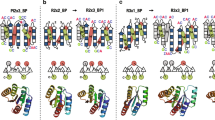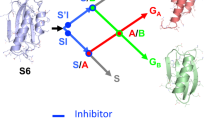Abstract
Backbone hydrogen bonds (H-bonds) are prominent features of protein structures; however, their role in protein folding remains controversial because they cannot be selectively perturbed by traditional methods of protein mutagenesis1,2,3. Here we have assessed the contribution of backbone H-bonds to the folding kinetics and thermodynamics of the PIN WW domain, a small β-sheet protein4, by individually replacing its backbone amides with esters. Amide-to-ester mutations site-specifically perturb backbone H-bonds in two ways: a H-bond donor is eliminated by replacing an amide NH with an ester oxygen, and a H-bond acceptor is weakened by replacing an amide carbonyl with an ester carbonyl5,6,7,8,9,10,11,12,13. We perturbed the 11 backbone H-bonds of the PIN WW domain by synthesizing 19 amide-to-ester mutants. Thermodynamic studies on these variants show that the protein is most destabilized when H-bonds that are enveloped by a hydrophobic cluster are perturbed. Kinetic studies indicate that native-like secondary structure forms in one of the protein's loops in the folding transition state, but the backbone is less ordered elsewhere in the sequence. Collectively, our results provide an unusually detailed picture of the folding of a β-sheet protein.
This is a preview of subscription content, access via your institution
Access options
Subscribe to this journal
Receive 51 print issues and online access
$199.00 per year
only $3.90 per issue
Buy this article
- Purchase on Springer Link
- Instant access to full article PDF
Prices may be subject to local taxes which are calculated during checkout



Similar content being viewed by others
References
Dill, K. A. Dominant forces in protein folding. Biochemistry 29, 7133–7155 (1990)
Honig, B. & Yang, A. S. Free energy balance in protein folding. Adv. Protein Chem. 46, 27–58 (1995)
Myers, J. K. & Pace, C. N. Hydrogen bonding stabilizes globular proteins. Biophys. J. 71, 2033–2039 (1996)
Sudol, M. Structure and function of the WW domain. Prog. Biophys. Mol. Biol. 65, 113–132 (1996)
Thorson, J. S., Chapman, E. & Schultz, P. G. Analysis of hydrogen bonding strengths in proteins using unnatural amino acids. J. Am. Chem. Soc. 117, 9361–9362 (1995)
Chapman, E., Thorson, J. S. & Schultz, P. G. Mutational analysis of backbone hydrogen bonds in staphylococcal nuclease. J. Am. Chem. Soc. 119, 7151–7152 (1997)
Koh, J. T., Cornish, V. W. & Schultz, P. G. An experimental approach to evaluating the role of backbone interactions in proteins using unnatural amino acid mutagenesis. Biochemistry 36, 11314–11322 (1997)
Shin, I., Ting, A. Y. & Schultz, P. G. Analysis of backbone hydrogen bonding in a β-turn of staphylococcal nuclease. J. Am. Chem. Soc. 119, 12667–12668 (1997)
Haque, T. S., Little, J. C. & Gellman, S. H. Stereochemical requirements for β-hairpin formation: model studies with four-residue peptides and depsipeptides. J. Am. Chem. Soc. 118, 6975–6985 (1996)
Wales, T. E. & Fitzgerald, M. C. The energetic contribution of backbone–backbone hydrogen bonds to the thermodynamic stability of a hyperstable p22 Arc repressor mutant. J. Am. Chem. Soc. 123, 7709–7710 (2001)
Silinski, P. & Fitzgerald, M. C. Comparative analysis of two different amide-to-ester bond mutations in the β-sheet of 4-oxalocrotonate tautomerase. Biochemistry 42, 6620–6630 (2003)
Beligere, G. S. & Dawson, P. E. Design, synthesis, and characterization of 4-ester CI2, a model for backbone hydrogen bonding in protein α-helices. J. Am. Chem. Soc. 122, 12079–12082 (2000)
Blankenship, J. W., Balambika, R. & Dawson, P. E. Probing backbone hydrogen bonds in the hydrophobic core of GCN4. Biochemistry 41, 15676–15684 (2002)
Chen, H. I. et al. Characterization of the WW domain of human yes-associated protein and its polyproline-containing ligands. J. Biol. Chem. 272, 17070–17077 (1997)
Koepf, E. K., Petrassi, H. M., Sudol, M. & Kelly, J. W. WW: an isolated three-stranded antiparallel β-sheet domain that unfolds and refolds reversibly; evidence for a structured hydrophobic cluster in urea and GdnHCl and a disordered thermal unfolded state. Protein Sci. 8, 841–853 (1999)
Crane, J. C., Koepf, E. K., Kelly, J. W. & Gruebele, M. Mapping the transition state of the WW domain β-sheet. J. Mol. Biol. 298, 283–292 (2000)
Jager, M., Nguyen, H., Crane, J. C., Kelly, J. W. & Gruebele, M. The folding mechanism of a β-sheet: the WW domain. J. Mol. Biol. 311, 373–393 (2001)
Kowalski, J. A., Liu, K. & Kelly, J. W. NMR solution structure of the isolated apo Pin1 WW domain: comparison to the X-ray crystal structures of Pin1. Biopolymers 63, 111–121 (2002)
Kaul, R., Deechongkit, S. & Kelly, J. W. Synthesis of a negatively charged dibenzofuran-based β-turn mimetic and its incorporation into the WW miniprotein-enhanced solubility without a loss of thermodynamic stability. J. Am. Chem. Soc. 124, 11900–11907 (2002)
Nguyen, H., Jager, M., Moretto, A., Gruebele, M. & Kelly, J. W. Tuning the free-energy landscape of a WW domain by temperature, mutation, and truncation. Proc. Natl Acad. Sci. USA 100, 3948–3953 (2003)
Ferguson, N., Johnson, C. M., Macias, M., Oschkinat, H. & Fersht, A. Ultrafast folding of WW domains without structured aromatic clusters in the denatured state. Proc. Natl Acad. Sci. USA 98, 13002–13007 (2001)
Ferguson, N. et al. Using flexible loop mimetics to extend Φ-value analysis to secondary structure interactions. Proc. Natl. Acad. Sci. USA 98, 13008–13013 (2001)
Joseph, J. D., Yeh, E. S., Swenson, K. I., Means, A. R. & Winkler, K. E. The peptidyl–prolyl isomerase Pin1. Prog. Cell Cycle Res. 5, 477–487 (2003)
Ranganathan, R., Lu, K. P., Hunter, T. & Noel, J. P. Structural and functional analysis of the mitotic rotamase Pin1 suggests substrate recognition is phosphorylation dependent. Cell 89, 875–886 (1997)
Deechongkit, S., You, S.-L. & Kelly, J. W. Synthesis of side chain protected chiral α-hydroxy acids for Boc solid phase peptide synthesis. Org. Lett. 6, 497–500 (2004)
Baskakov, I. & Bolen, D. W. Forcing thermodynamically unfolded proteins to fold. J. Biol. Chem. 273, 4831–4834 (1998)
Fersht, A. R., Matouschek, A. & Serrano, L. The folding of an enzyme. I. Theory of protein engineering analysis of stability and pathway of protein folding. J. Mol. Biol. 224, 771–782 (1992)
Nymeyer, H., Socci, N. D. & Onuchic, J. N. Landscape approaches for determining the ensemble of folding transition states: success and failure hinge on the degree of frustration. Proc. Natl Acad. Sci. USA 97, 634–639 (2000)
Bramson, H. N., Thomas, N. E. & Kaiser, E. T. The use of N-methylated peptides and depsipeptides to probe the binding of heptapeptide substrates to cAMP-dependent protein kinase. J. Biol. Chem. 260, 5452–5457 (1985)
Gruebele, M., Sabelko, J., Ballew, R. & Ervin, J. Laser temperature jump induced protein refolding. Acc. Chem. Res. 31, 699–707 (1998)
Acknowledgements
We thank S. You, J. Blankenship and R. Balambika for discussions. We acknowledge financial support from the NIH, The Skaggs Institute for Chemical Biology, the Lita Annenberg Hazen Foundation and the Norton B. Gilula Fellowship (to S.D.). M.G. and H.N. were supported by a grant from the NSF. P.E.D. was supported by the NIH and the Alfred P. Sloan Foundation.
Author information
Authors and Affiliations
Corresponding author
Ethics declarations
Competing interests
The authors declare that they have no competing financial interests.
Supplementary information
Supplementary Information
Contains the raw data used to calculate ΦM values (two figures and one table), and a plot of ΦM as a function of temperature for all of the A-to-E mutants with TM > 35 °C. (PDF 187 kb)
Rights and permissions
About this article
Cite this article
Deechongkit, S., Nguyen, H., Powers, E. et al. Context-dependent contributions of backbone hydrogen bonding to β-sheet folding energetics. Nature 430, 101–105 (2004). https://doi.org/10.1038/nature02611
Received:
Accepted:
Issue Date:
DOI: https://doi.org/10.1038/nature02611
This article is cited by
-
The major role of London dispersion interaction in the assembly of cellulose, chitin, and chitosan
Cellulose (2023)
-
Hydrogen-bonding regulated supramolecular chirality with controllable biostability
Nano Research (2022)
-
Proteomimetics as protein-inspired scaffolds with defined tertiary folding patterns
Nature Chemistry (2020)
-
The peptide hormone glucagon forms amyloid fibrils with two coexisting β-strand conformations
Nature Structural & Molecular Biology (2019)
-
A prevalent intraresidue hydrogen bond stabilizes proteins
Nature Chemical Biology (2016)
Comments
By submitting a comment you agree to abide by our Terms and Community Guidelines. If you find something abusive or that does not comply with our terms or guidelines please flag it as inappropriate.



